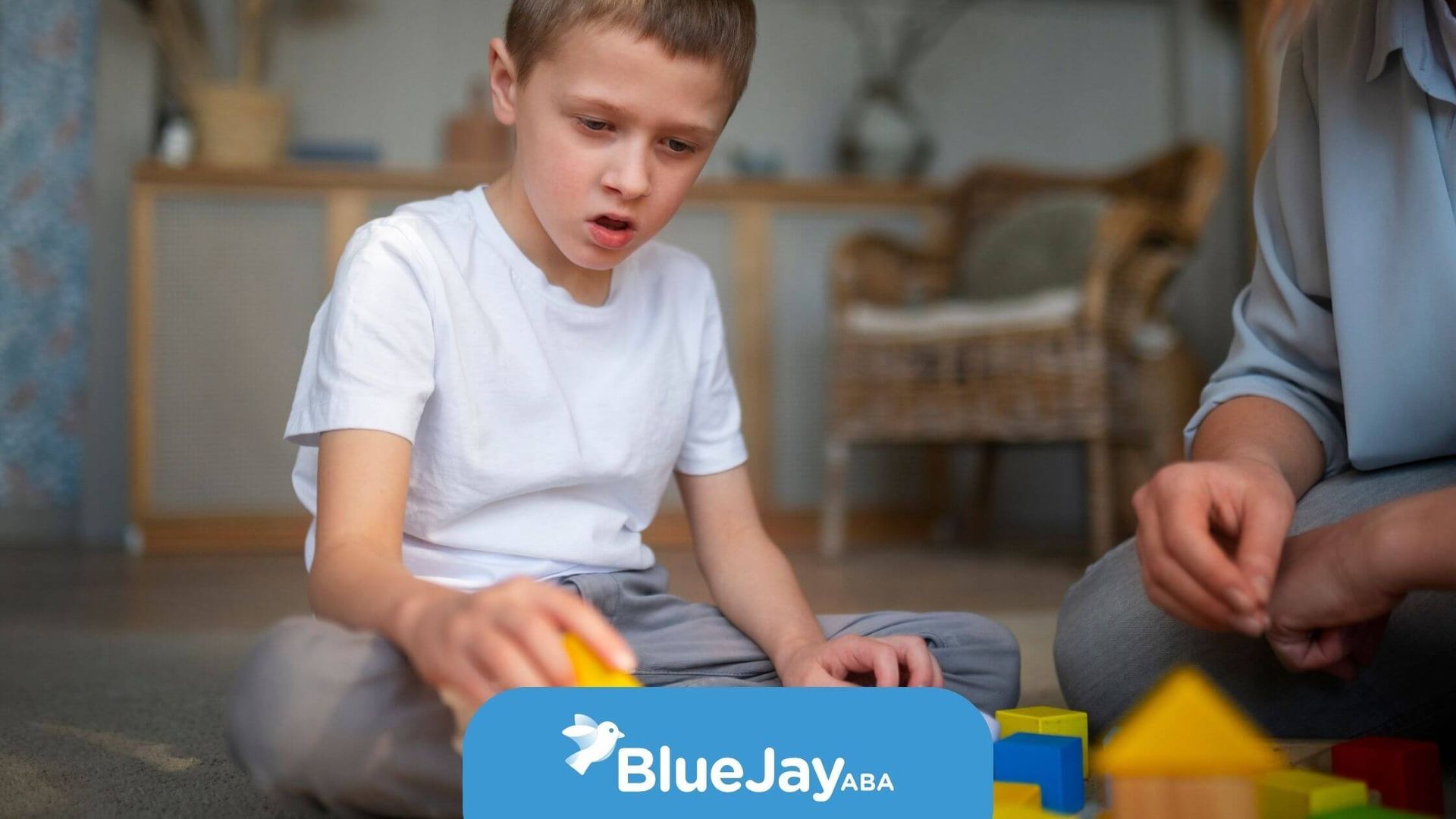Understanding Sensory Issues in High-Functioning Autism and How to Manage Them
For many families, managing sensory sensitivities is most effective when support is delivered in the comfort of their own home. In familiar surroundings, therapists can better observe triggers, adjust strategies in real time, and help children apply coping skills where they matter most. This personalized, environment-specific approach makes a significant difference for individuals with high-functioning autism who struggle with sensory regulation.
That’s why Blue Jay ABA offers in-home ABA therapy services tailored to each child’s sensory and behavioral needs, creating meaningful change right where it happens—at home.
Now let’s explore what these challenges look like and how they can be managed effectively
.
The Link Between High-Functioning Autism and Sensory Sensitivities
What is High-Functioning Autism?
High-functioning autism is a term used to describe individuals on the autism spectrum who have average or above-average intelligence and strong verbal abilities. While they may excel academically or professionally, social interactions, sensory processing, and emotional regulation can present significant hurdles.
It's important to note that "high-functioning" doesn’t mean someone doesn’t face challenges—it simply means they don’t require the same level of support as someone with more profound autism traits. Sensory sensitivities can be just as intense, and in some cases, even more distressing because they may not always receive the accommodations they need.
Why Do Sensory Sensitivities Happen?
Sensory processing differences occur because the autistic brain interprets sensory input differently. Think of it as having a radio with the volume stuck on high or too low—some signals come in too loud, while others are barely noticeable. This can affect:
- Sight: Bright lights, flashing screens, or certain color contrasts may be overwhelming.
- Sound: Everyday noises, like sirens, school bells, or a room full of chatter, can be unbearable.
- Touch: Clothing tags, specific textures, or light touches might feel painful.
- Taste & Smell: Certain foods, perfumes, or cleaning products can be overwhelming or even nauseating.
- Balance & Body Awareness: Difficulty sensing where their body is in space, leading to clumsiness or the need for deep pressure (like tight hugs or weighted blankets).
Understanding these differences can help create moresupportive environments for individuals with high-functioning autism.
Recognizing Sensory Processing Differences in High-Functioning Autism
Hypersensitivity: When Everything Feels "Too Much"
Hypersensitivity means an individual experiences sensory input much more intensely than others. Everyday sensations can become overwhelming, triggering anxiety, discomfort, or even pain.
Common Signs of Hypersensitivity:
- Avoiding bright lights or loud environments
- Startling easily at unexpected sounds
- Struggling with certain fabric textures or clothing tags
- Being highly sensitive to temperature changes
- Refusing specific foods due to texture or taste
Real-Life Example:
Elsa, a 12-year-old with high-functioning autism, avoids the school cafeteria because the mix of smells, chatter, and fluorescent lights gives her headaches. To manage, she wears
noise-canceling headphones and eats lunch in a quieter space.
Hyposensitivity: When More Stimulation is Needed
Hyposensitivity means an individual has a reduced response to sensory input, requiring more intense stimulation to register sensations.
Common Signs of Hyposensitivity:
- Seeking out deep pressure (hugs, weighted blankets)
- Not noticing injuries or pain immediately
- Engaging in repetitive motions like rocking or spinning
- Enjoying strong flavors or crunchy foods
- Frequently touching objects or people for sensory input
Real-Life Example:
Louis, a 9-year-old with high-functioning autism, often crashes into furniture and chews on his shirt sleeves. His therapist introduces sensory-friendly alternatives, like a weighted vest and chewy necklaces, to help regulate his sensory needs.
Managing Sensory Overload in Different Settings
At Home: Creating a Sensory-Friendly Space
- Use dimmable lighting and avoid fluorescent bulbs.
- Set up a quiet corner with soft textures and weighted blankets.
- Provide noise-canceling headphones or calming background music.
- Offer fidget toys or stress balls to help with self-regulation.
At School: Supporting Sensory Needs in the Classroom
- Allow flexible seating (e.g., standing desks, wobble cushions).
- Minimize loud classroom environments or provide "quiet zones."
- Use visual schedules to reduce anxiety about transitions.
- Offer sensory breaks for students who need time to reset.
In Public Places: Navigating Sensory Triggers
- Plan grocery trips during off-peak hours to avoid crowds.
- Carry sunglasses or hats to reduce bright-light exposure.
- Identify quiet spaces in malls, parks, or restaurants for breaks.
- Use weighted backpacks or compression clothing to provide grounding pressure.
Professional Support for Sensory Processing Challenges
Occupational Therapy (OT)
OT helps individuals develop coping strategies for sensory sensitivities, using techniques like deep pressure therapy, sensory diets, and proprioceptive exercises to improve regulation.
Applied Behavior Analysis (ABA) Therapy
ABA therapy helps children with high-functioning autism manage sensory challenges by teaching self-regulation skills, promoting independence, and encouraging communication about sensory needs.
Cognitive Behavioral Therapy (CBT)
CBT can help autistic individuals managesensory-related anxiety by changing thought patterns and introducing relaxation techniques to cope with overwhelming situations.
Conclusion
Sensory processing challenges can make daily life overwhelming, but with the right strategies and support, individuals with high-functioning autism can thrive. Understanding sensory needs, creating autism-friendly spaces, and using tools like sensory breaks, fidget toys, and noise-canceling headphones can significantly improve comfort and well-being.
At Blue Jay ABA, we specialize in helping autistic individuals manage sensory sensitivities through evidence-based ABA therapy. If you’re looking for expert guidance and personalized support, reach out today to learn how we can help.
Let’s create an environment where every individual can feel safe, comfortable, and empowered to be themselves!
FAQs
Do individuals with high-functioning autism experience sensory issues?
Yes, many individuals with high-functioning autism experience sensory processing challenges. These can include heightened sensitivity to sounds, lights, textures, and other stimuli, or the need for additional sensory input to feel regulated.
What causes sensory overload in high-functioning autism?
Sensory overload occurs when the brain struggles to process incoming sensory information efficiently. This can happen due to hypersensitivity (over-responsiveness) to stimuli like bright lights, loud noises, or certain textures.
How can sensory sensitivities affect daily life?
Sensory issues can impact various aspects of life, including difficulty concentrating in noisy environments, discomfort with certain clothing, avoidance of social gatherings, or experiencing meltdowns due to overwhelming sensory input.
Sources:
- https://familydoctor.org/condition/sensory-processing-disorder-spd/
- https://www.autismspeaks.org/sensory-issues
- https://childmind.org/article/sensory-processing-issues-explained/
- https://dibs.duke.edu/news/high-functioning-autism-symptoms-diagnosis-and-support/
- https://pmc.ncbi.nlm.nih.gov/articles/PMC3071047/
Related Posts






